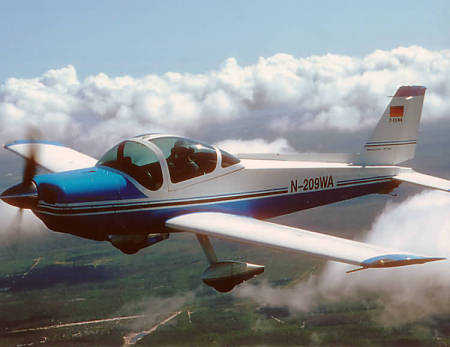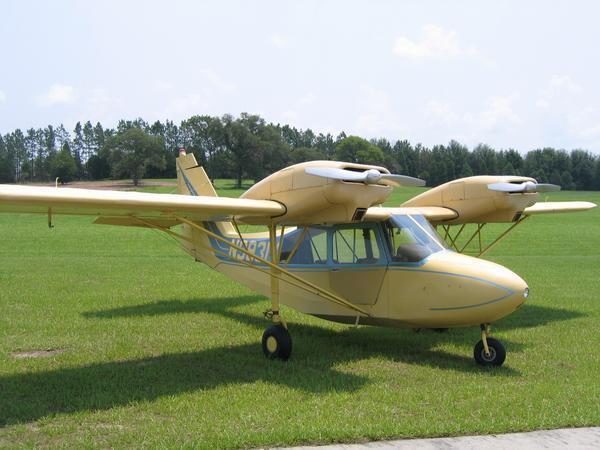I’ve never heard of a precautionary tale…but I think I know what you mean…
RobertL18C wrote:
The Twin Champ or Lancer, with fixed pitch props, not exactly the cleverest of twin engine trainers – I wonder how many were produced?
Not many. Thirty-six, it says here.
It also says “Sales were very limited and failed to meet Champion’s expectations; some sources state that a total of 36 were made, although others claim that only 24 or 26 may have actually been delivered”
The Twin Champ or Lancer, with fixed pitch props, not exactly the cleverest of twin engine trainers – I wonder how many were produced?
BackPacker wrote:
A few of the Piper Cadets I trained in, while at OFT (KISM), had exactly this device: A mock gear up/down lever. It was incredibly annoying during night circuit practice since the green “gear down&locked” lights could not be dimmed, and when you selected “gear up” (green lights out) all sorts of warnings sounded when the MAP or the speed dropped below a certain value. And they could not be disabled.
Aircraft with odd features added for training is an occasionally recurring theme…
Retractable gear, with the risk and complexity that entails, minus meaningful speed benefit…

Twin engines, where one has proven better…

dublinpilot wrote:
Maybe there is a market for a little box to be velcrowed into training aircraft that has three green lights and an up/down switch for training. Very occaionally when flicked down, some of the three green lights don’t come on.
A few of the Piper Cadets I trained in, while at OFT (KISM), had exactly this device: A mock gear up/down lever. It was incredibly annoying during night circuit practice since the green “gear down&locked” lights could not be dimmed, and when you selected “gear up” (green lights out) all sorts of warnings sounded when the MAP or the speed dropped below a certain value. And they could not be disabled.
Eventually we figured out how to pull the bulbs.
This is not the first such accident.
A similar incident was caught on tape and aired during one of the episodes of Ice Pilots NWT. In this case it was a C-215 waterbomber with high wings and even higher engines. So there was no damage to the flying surfaces or props, but they did scrape off quite a bit of the fuselage.
Peter wrote:
The bit I don’t get is why, with the plane scraping along the tarmac, somebody thought it would be a good idea to take off again.
It has happened to at least one airliner as well: Malév Flight 262
Fortunately they could land after a circuit without hurting anyone. Moreover, most passengers said that they did not feel anything unusual on the first attempt, when they landed without the gear extended.
Addition: according to some sources in Hungarian, not even the pilots were immediately sure after the go-around about the problem with their first landing.
An other explanation – or contributing factor – could be, that they had briefed touch-and-goes and thus could have fallen into the briefed pattern.
EuroFlyer wrote:
Why don’t you just stay out of it and wait until we know more from the BFU; you will have time enough to disseminate all kinds of stories and anecdotes in that matter.
Because he explicitly said it was hearsay and opened a discussion about procedures and checklists, that could very well be based on any hypothetical incidence. After all, you first mentioned the incidence on which this “tale” is based upon. Only because this very accident isn’t investigated, doesn’t mean we can’t all learn from it.
Peter wrote:
The bit I don’t get is why, with the plane scraping along the tarmac, somebody thought it would be a good idea to take off again.
I think there are several explanations for that. First, everybody is taught that it is never too late for a go-around. So something is wrong – go around and try it again. With insufficient time to analyse the problem (short runway maybe) this might explain why they did it. Next there is a strong tendency of many people (including pilots!) to cover-up their blunder. So go-around, lower the gear, land again and quietly push the plane into some dark corner of the hangar before anyone notices may have been the plan here. Or even the idea of going around and do another circuit with enough time to lower the gear in order to prevent further damage to the aircraft.
This is not the first such accident. I recall an accident report I read maybe 10 years ago. It was a C421 during a checkride (in the UK IIRC) with student and instructor in the front and the examiner, who was too big to fit in the cockpit, watching from the rear. They too tried to go-around after hitting their props against the concrete but due to the damaged engines and propellers hit some trees they could not outclimb. The impact was survivable and both pilots from the front seats escaped, but the examiner burnt to death in the cabin because he was too heavy for them to pull him out.
The bit I don’t get is why, with the plane scraping along the tarmac, somebody thought it would be a good idea to take off again.
dublinpilot wrote:
But I suspect most schools wouldn’t be interested and see it as just a distraction.
I suspect it’s a distraction at the start of a PPL, and could lead to some unnecessary frustration / flustering from the students. It is really only useful for people who fly both retractable and fixed.